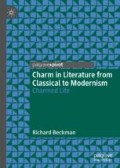Abstract
The author contends that Spenser saw only the perilous side of charm, personified as Duessa, fetching—as some might find Roman Catholicism. If something is attractive, beware.
In his epic apologue, The Faerie Queene, charm as such is merely deceit, whether in a fetching woman or a sensuous religion, an instrument of Roman Catholicism and its sensuous theatricality, outward images that would only distract the inner quest for that holiness which alone pleases God. Here charm is dangerous, and artful images are snares and delusions, thieves of holiness. The Counter-Reformation was underway and the Reformation (and the Church of England) required a strong defense. No time for graven images. He throws the baby out with the bathwater.
Access this chapter
Tax calculation will be finalised at checkout
Purchases are for personal use only
Author information
Authors and Affiliations
Rights and permissions
Copyright information
© 2019 The Author(s)
About this chapter
Cite this chapter
Beckman, R. (2019). Spenser Versus Charm. In: Charm in Literature from Classical to Modernism. Palgrave Pivot, Cham. https://doi.org/10.1007/978-3-030-25345-5_4
Download citation
DOI: https://doi.org/10.1007/978-3-030-25345-5_4
Published:
Publisher Name: Palgrave Pivot, Cham
Print ISBN: 978-3-030-25344-8
Online ISBN: 978-3-030-25345-5
eBook Packages: Literature, Cultural and Media StudiesLiterature, Cultural and Media Studies (R0)

